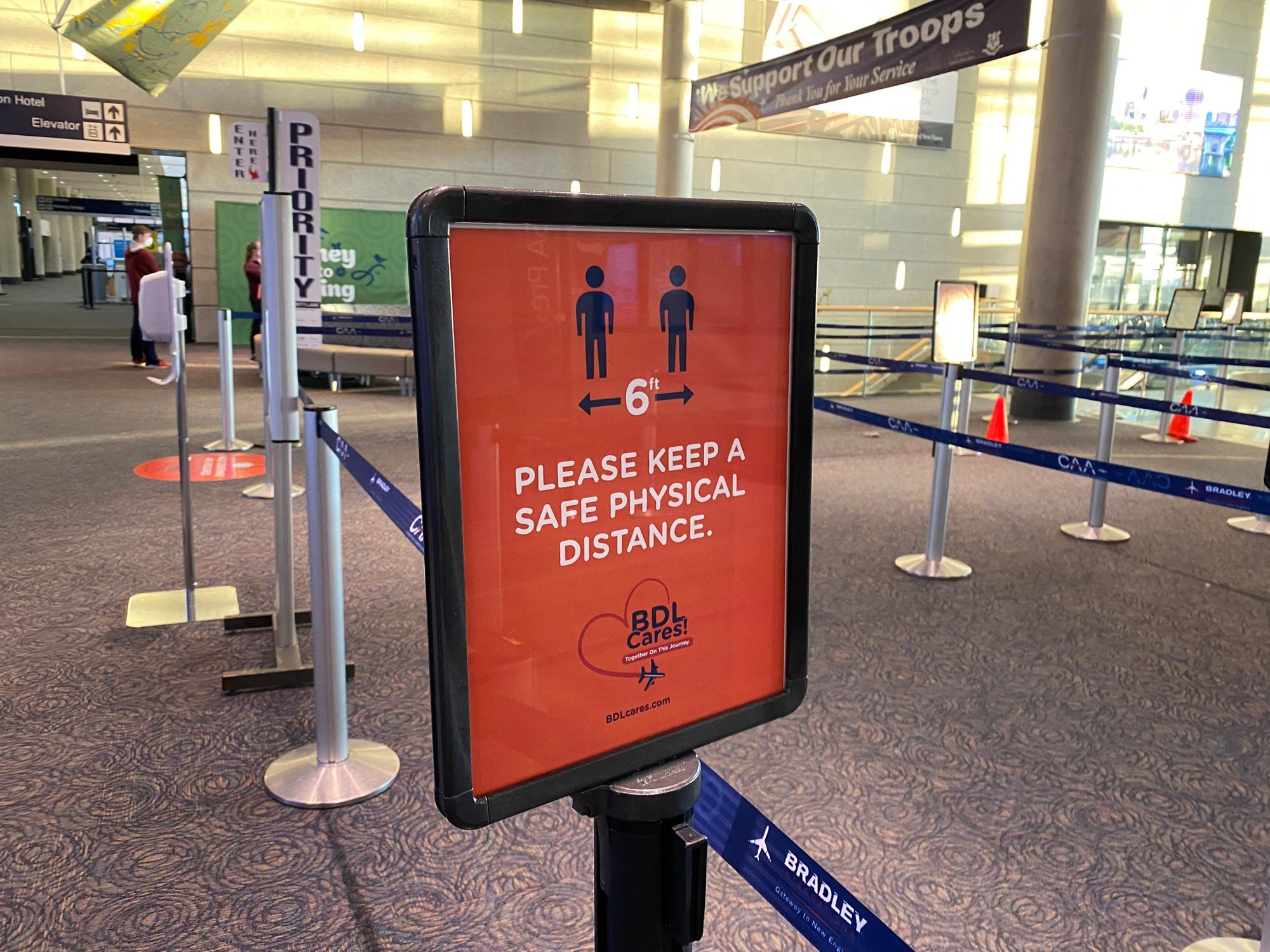- Visiting airports in Hartford, Connecticut, Atlanta, and Charlotte, I saw how each is coping with social distancing and rising passenger numbers, as well as disparities across the three major airports.
- While Hartford’s Bradley International had strict social distancing guidelines and required masks, Hartsfield-Jackson Atlanta International and Charlotte Douglas International did not have the same rules.
- The differences at each airport could also be seen with passengers, as those in Charlotte seemed to care little about distancing while those in Atlanta and Hartford were more aware of it.
- Visit Business Insider’s homepage for more stories.
If there was one thing I took away from flying during a pandemic, it’s that there’s no coordinated response in the aviation industry to handle the rising number of passengers in our nation’s airports.
In the first week of June, I flew from Hartford, Connecticut to Atlanta and back via Charlotte. It was the first time I had flown since February and I was eager to see how much the industry that I write about on a daily basis had changed in four months.
On my journey, I’d be flying on three flights, visiting three airports on two major airlines, American and Delta. I knew roughly what to expect on my airlines, as Business Insider has been keeping track of most major airline policy changes when it comes to social distancing, but the airport experience would be a different story as there was increasingly less focus on airports.
This trip would have me visit some of the busiest airports in the US, including Hartsfield-Jackson Atlanta International Airport and Charlotte Douglas International Airport, as well as Hartford’s Bradley International Airport.
Here's what it was like.
My journey started at Bradley International Airport, a medium-sized airport serving the areas of Hartford, Connecticut, and Springfield, Massachusetts. As expected for my 5:30 a.m. arrival, it was largely quiet.

As soon as I parked my car and started walking through the terminal garage, I was greeted with this reminder to wear a face-covering while in the airport terminal. It wouldn't be the first time I saw this sign.

The same orange, white, and blue reminders were displayed throughout the terminal, unavoidable to travelers passing through Bradley's doors.

They were also commonplace at check-in,

And the security checkpoint line.

This was in addition to the placards placed by airlines themselves. Here's one from Delta.

After getting my boarding pass, I headed through security and availed myself to the pre-security hand sanitizer dispenser. That day saw 267,742 travelers passing through TSA security screenings.

Source: TSA
In a stark reminder of aviation's slow recovery, the eight-hour period from 6:30 a.m. to 2:30 p.m. would only see 10 aircraft would depart from Hartford.

I had been in the airport all of 10 minutes and had seen this reminder at least that many times. It was kind of dystopian at this point, a lingering reminder of the state of our world.

All the businesses on the way to the gate that were not located in the base of the terminal sat closed, unable to serve passengers.

Connecticut was still in the early phases of reopening so only select businesses were open.

Non-essentials, like this candy shop, could not sell their wares to the captive customers seeking last-minute treats and goodies before their flights.

Social distancing in the 12-gate terminal proved quite easy due to the lack of flights departing at the early hour.

But as I was traveling to what was the country's busiest airport prior to the pandemic, I knew the story would likely be different later in the day.

While the airport was focused on signage and strategically placed hand sanitizer dispensers, each airline had its own style of social distancing at their gates.

Southwest Airlines, for example, erected partitions at its gate to have a barrier between passengers and gate staff.

I was flying Delta that morning and though the airline hadn't installed partitions at the counter, there were social distancing placards in the gate area just like at check-in. Passengers queueing to board largely did so with distancing in mind.

There was more signage in the jetway placed by Delta. Everything at the gate and beyond was in the airline's control rather than the airport's.

For my first day back, I was feeling good about how the industry had approached social distancing.

Arriving in Atlanta, however, was a different story. Though the terminals were similarly less crowded than normal, I would not have known that social distancing was a thing just based on this visit.

Masks were not required in the airport and reminders to maintain distancing were scarce. As I was heading out of the terminal, I didn't get to see the full scope of how Atlanta's airport was handling the pandemic until I returned later that day.

There were some placards placed on the ground at high traffic areas like the hotel shuttle pickup area but that was about it. The airport's website says that the placards are placed primarily in queueing areas, the arrival areas, and on the trains that serve the airport.

Pulling back up to the airport for my return journey, the first thing I noticed was a lack of the social distancing signage so prominently displayed in Hartford.

Unlike Bradley, there was no signage or guidance outside the terminal.

Customer-facing employees are mandated to wear face coverings but not passengers themselves.

Source: Atlanta Airport
While initially surprised that such a busy airport would have a laissez-faire policy, my concerns were lessened once I stepped foot in the airport and saw it virtually empty.

Delta had consolidated a lot of its Atlanta operation which meant shutting down numerous check-in areas.

Hartsfield-Jackson International Airport consistently ranks as the busiest airport in the US and is the pride of the country's second-largest airline, Delta, but it was a shell of its former self during my visit.

The airport states that it placed over 300 hand sanitizer stations at the airport but they were hard to find, I didn't notice many and I was actively on the lookout for them.

Finally, some guidance on face coverings, but by no means requiring or recommending their use in the airport.

There was similarly no line for the security checkpoint and the Transportation Security Administration was doing its part to aid social distancing by blocking certain stations at its automated x-ray machines.

Delta employees were waiting after the checkpoint to offer passengers of all airlines a squirt of hand sanitizer. The airport's hand sanitizer machine was also there as a backup.

The airport had placed additional placards at stations for its underground train that shuttles passengers between terminals.

On our way to the gate, we visited Atlanta's B Concourse, which had been closed entirely to passengers.

The 36-gate strong concourse was rendered useless due to the pandemic.

And all of its businesses were closed. As Georgia was in the midst of reopening, some restaurants in the airport were beginning to open their doors again but not the ones in this deserted concourse.

American Airlines had opted to erect partitions at its gates and limit the number of boarding lanes to one.

There were also pieces of tape with reminders to stay six feet apart.

The last airport I'd visit on this journey was Charlotte Douglas International Airport on a layover back to Hartford.

The airport appeared to be the busiest I had visited the entire trip. Luckily, I was only there for about an hour.

Social distancing seemed like a foreign concept with passengers not caring about staying apart. There were also some obvious pitfalls, including consolidating escalators to save energy.

I applaud the energy-efficient efforts but in reality, shutting down two escalators leads to crowding on the remaining ones.

No one seemed to mind lining up for food or congregating in the gate areas, mask or no mask.

The airport did have hand sanitizer stations, though very few in number.

They were commonly found just after security screening checkpoints and in high-traffic areas.

There was also more guidance on how to social distance than what was seen in Atlanta, though nobody in the graphic was wearing a mask.

Charlotte, too, was affected by the lack of traffic as seen with its newly opened A Concourse.

All the businesses in this brand-new piece of aviation infrastructure were closed and there was not a soul in sight.

Most reminders to social distance came from some of the airport's businesses.

Here's the scene at a Starbucks, where placards and signage were placed to serve as reminders.

It didn't appear that the passengers were too bothered with the arrangement as they were content to queue just as they would in normal times.

I'd then fly back to Hartford, where face coverings were required in the airport, on an airline that required face coverings.

The discrepancies of each airport's policies were the most confusing, especially with how poorly some of them aligned with airline policy. It's not to say that face coverings shouldn't be required, as each airport and airline is entitled to its preference, but the lack of consistency makes the system fall down.
What was the point of mandating a face covering in Hartford if they weren't required in Atlanta or Charlotte? Why did I have to wear a mask on my American Airlines flight but not when in its hub at Charlotte Douglas International?
After visiting these three airports, I not only saw what each was doing for their customers but how the perceptions of the pandemic changed across state lines. Although there were more reported COVID-19 cases in Georgia than Connecticut, there were more social distancing guidelines at Hartford's airport than there were in Atlanta's.
When passing through North Carolina, where cases have barely topped 30,000, I couldn't even tell that there was a pandemic going on, except for more passengers wearing masks than normal. It was in Charlotte that I saw just how far aviation has to go when it comes to getting back to normal since it appeared to be the busiest airport I'd visited and also the one with the least precautions.
In the end, however, there's only so much an airport can do when its visitors don't seem keen on following social distancing guidelines. Packed gate areas, long lines for fast food, and crowded escalators didn't prove to me that the populace that is willing to travel in the first place was too worried about contracting COVID-19 while flying.

